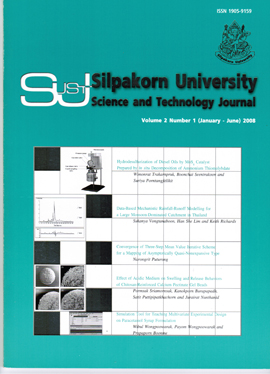Simulation Tool for Teaching Multivariate Experimental Design on Paracetamol Syrup Formulation
Main Article Content
Abstract
Computer simulation is one of effective tools for instructors to illustrate effects of experimental design in itsentire complexity since the students can be exposed to a large variety of experimental designs within a relativeshort period of time. In this study, the syrup formulation of paracetamol was used as a model topic. The programwritten as a Visual Basic module within Microsoft AccessTM was used to simulate the formulation behavior. The23 forth-year pharmacy students in Faculty of Pharmaceutical Sciences, Prince of Songkhla University used thisprogram to have direct experience in ‘EXPERIMENTAL DESIGN’ topic. The efficiency of the generatedcomputer simulation program on the students’ learning was determined by the evaluation of the satisfaction of thestudents using a questionnaire. The results suggested that this tool was useful and satisfactory for the students’self-studying.
Downloads
Article Details
References
Mezei, J., Kuttel, S., and Rácz, I. (1990). Computer-assisted instruction: how to solve drug formulation problems. American Journal of Pharmaceutical Education, 54: 30-34.
Hayton, W. L. and Collins, P. L. (1991). STELLA: Simulation software for pharmacokinetic software. American Journal of Pharmaceutical Education, 55: 131-134.
Chiholm, M. A., Dehoney, J., and Poirier, S. (1996). Development and evaluation of a computer assisted instructional program in an advanced pharmcotherapeutics course. American Journal of Pharmaceutical Education, 60: 365-369.
Ramanathan, M., Chau, R. I., and Straubinger, R. M. (1997). Integration of Internet-based technologies as a learning tool in a pharmaceutical calculations course. American Journal of Pharmaceutical Education, 61: 141-148.
Wongpoowarak, W. and Boonme, P. (2005). Computer simulation for studying effects of laboratory design on results of accelerated stability test. Silpakorn University International Journal, 5(1-2): 108-117.
Worakul, N., Wongpoowarak, W., and Boonme, P. (2002). Optimization in development of acetaminophen syrup formulation. Drug Development and Industrial Pharmacy, 28(3): 345-351 and 28(8): 1043-1045.
Derenzo E. (1977). Approximation for hand calculators using small integer coefficients. Mathematics of Computation, 31: 214-225.
Reynolds, J. E. F. (1993). Martindale: The Extra Pharmacopoeia, Pharmaceutical Press, London.

